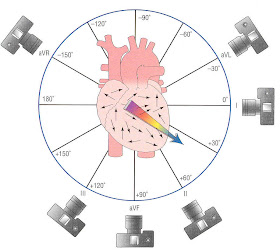ECG Basics
ECG Paper:
ECGs print out on a type of graph paper with specific measurements.

 Horizontally the paper gives a specific time measurement based on real time and the speed in which the paper prints. Each small box is 1mm/1mm and the paper prints at 25mm/sec
Horizontally the paper gives a specific time measurement based on real time and the speed in which the paper prints. Each small box is 1mm/1mm and the paper prints at 25mm/sec

 Horizontally the paper gives a specific time measurement based on real time and the speed in which the paper prints. Each small box is 1mm/1mm and the paper prints at 25mm/sec
Horizontally the paper gives a specific time measurement based on real time and the speed in which the paper prints. Each small box is 1mm/1mm and the paper prints at 25mm/sec- One small box is 0.04 seconds or 40 milliseconds
- One large box is 0.20 seconds or 200 milliseconds
- 5 large boxes equals one second.
Vertically the paper measures amplitude.
- Each small box is equal to 1mm or 1/10 mv
- 10 small boxes or 2 large boxes is equal to 1 mv
A lead is not the same thing as an electrode. A lead is a view of the hearts electrical activity taken from the placed electrodes. Different leads are used for different angles of view.
Bipolar leads - A bipolar lead uses two electrodes, each with different poles (positive/negative).
Your limb leads are the bipolar leads. The limb leads are leads I, II, and III. If you read the axis determination tutorial from the prehospital 12-lead blog, you are a step ahead and should understand this well. If not, just follow along.
The picture above shows you how we get our limb leads. Called limb leads due to the electrode placement.
- In lead I, the negative electrode is on the right arm and the positive on the left arm
- In lead II, the negative is also on the right arm and the negative is on the left leg
- In lead III, the left arm electrode is converted to negative polarity and the left leg is the positive.
Although it looks as if the view from each lead would completely bypass the heart, it doesn't Don't imagine the electrodes being on the wrists and ankles as in the picture. Although this is the appropriate placement, it is much easier to picture the view of the lead if you imagine torso placement. Check out the image below:
The cameras are displaying which angle we are viewing from. Since the positive electrode for lead I is on the left arm, the camera is on the left. This is a hexaxial diagram. This diagram is made up from the first six leads of a 12-lead, and can be formed using only the electrodes placed on the limbs. Leads I, II, III, aVR, aVL, & aVF.
Unipolar leads - Every other lead is a unipolar lead. They have only one true pole, and it is positive. The negative pole is comprised of many other electrodes. aVR, aVL, aVF, V1, V2, V3, V4, V5, and V6 are all unipolar leads.
Augmented limb leads - The a in aVR, aVL, and aVF stands for augmented vector. They are called augmented vectors because they are different angles of view. They use all the same electrodes as the limb leads. The difference is that the augmented limb leads uses a different negative pole. The negative electrode from leads I, II, and III is zeroed out and an exploring lead is created. This is possible due to Einthoven's law I + (-II) + III = 0, or I + III = II.
Check out the diagram below to see where the positive lead is located.
Precordial leads - These are also known as chest leads. V1, V2, V3, V4, V5, and V6 are the last 6 leads, and only viewable with a 12 lead. It is possible to use your limb leads for what is known as MCL or modified chest leads, but this has gone out of favor since 12-lead ECGs have become so common.
The limb leads and augmented limb leads make up the hexaxial reference system. This system shows all the views from the frontal plane. This is also the system that is used to reference the heart's electrical axis.
The electrical axis refers to the general direction of cardiac depolarization. More on this later, or continue reading through the axis determination tutorial.



hi, Apparently there is a mistake about I lead point of view. lead is "watching" from - to + that is from negative to positive direction, that's why arrow on I lead is directed towards LA. But in general I really enjoy the source.
ReplyDelete